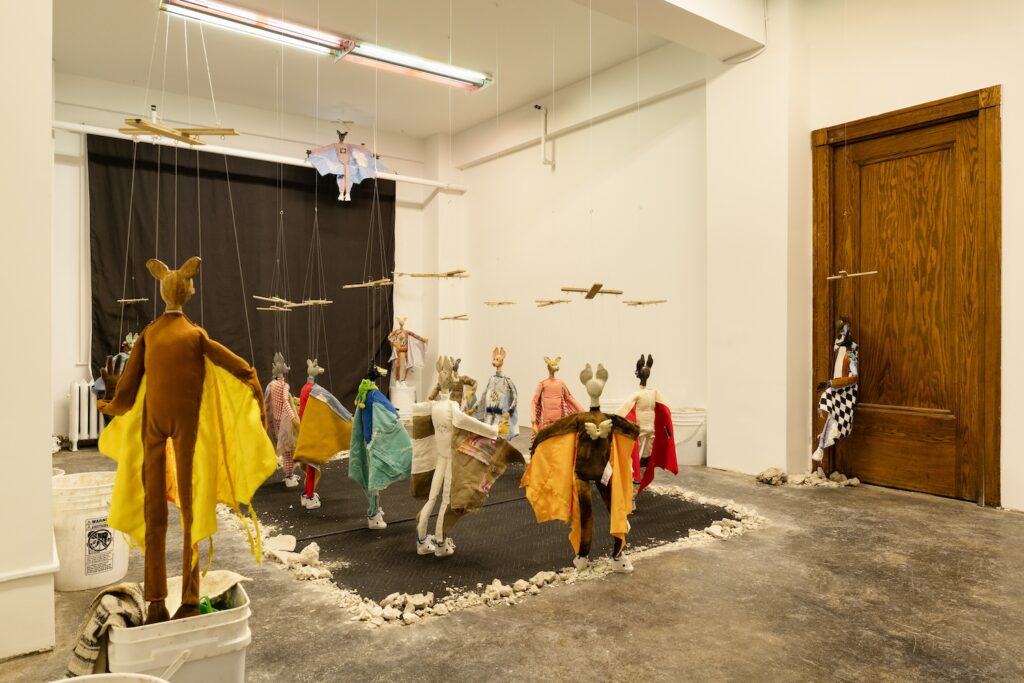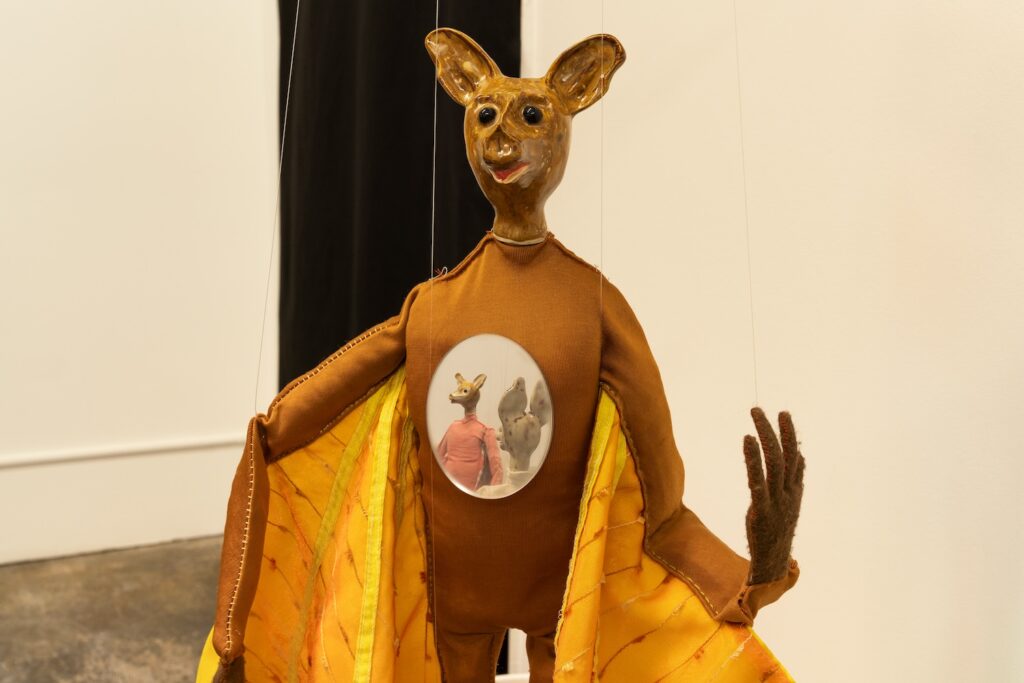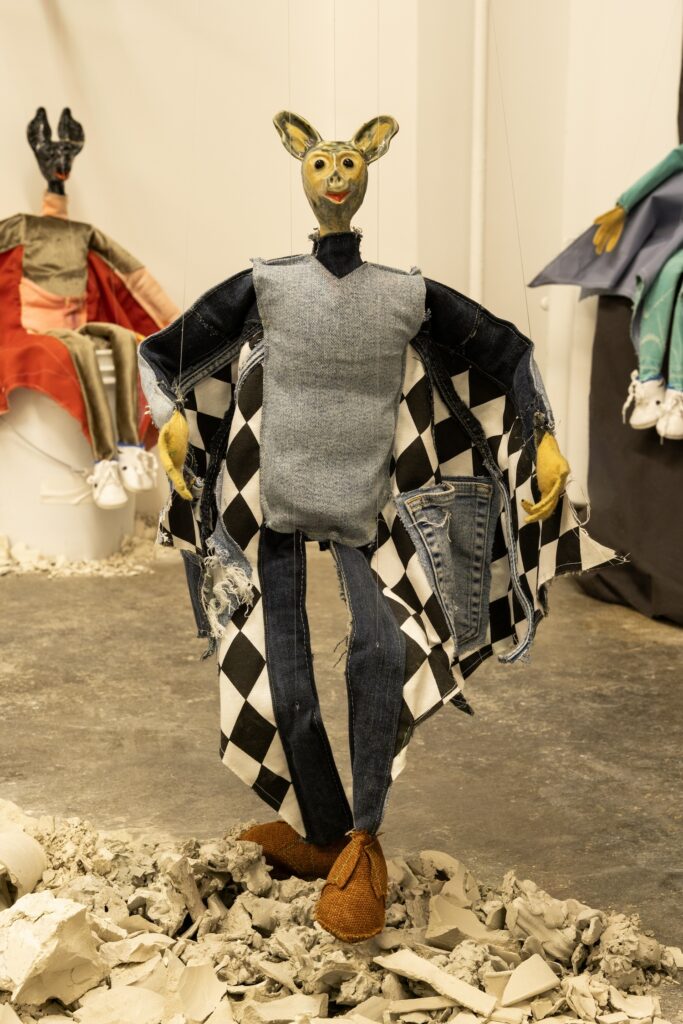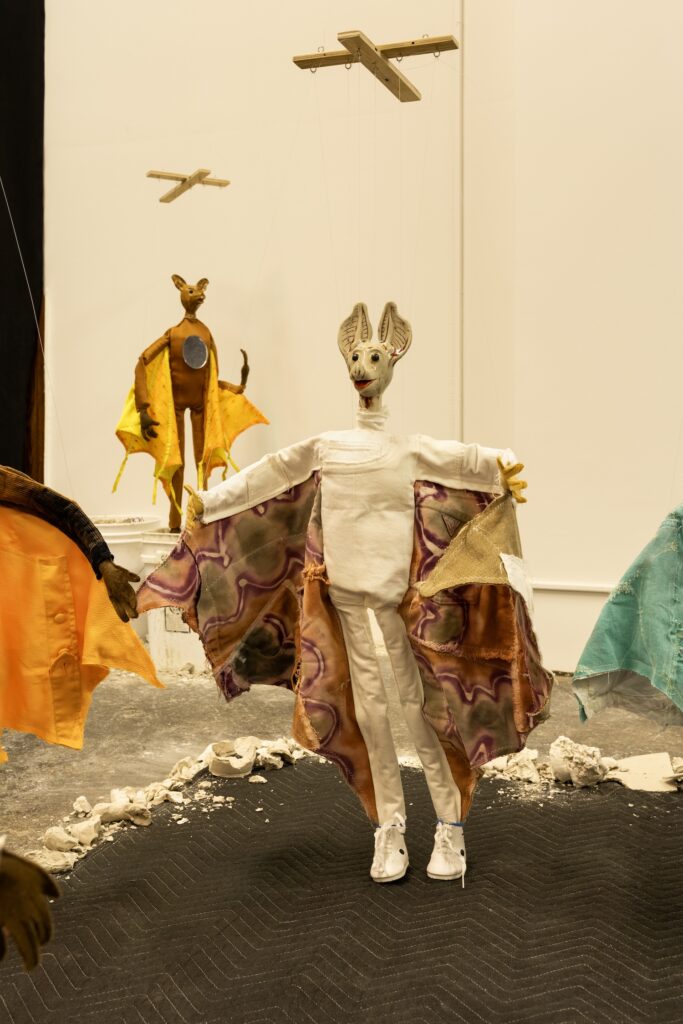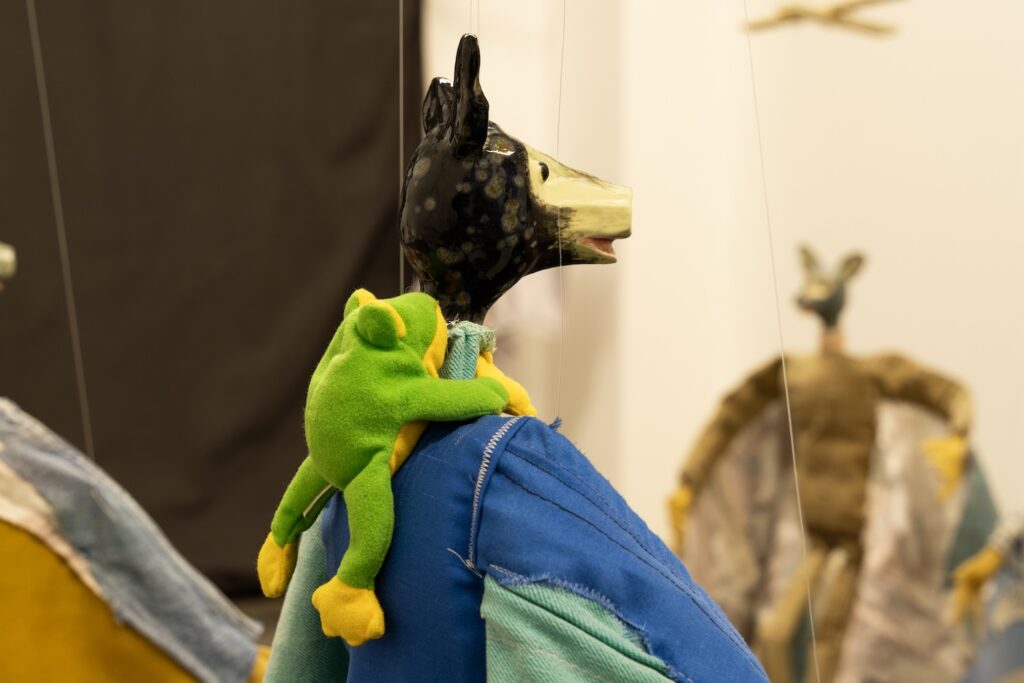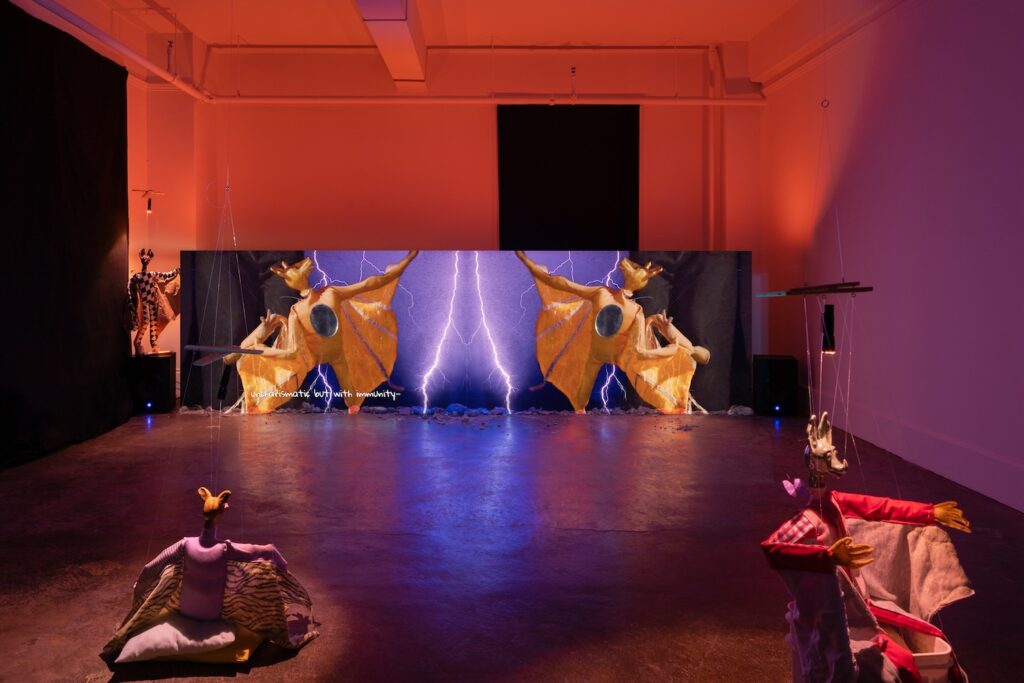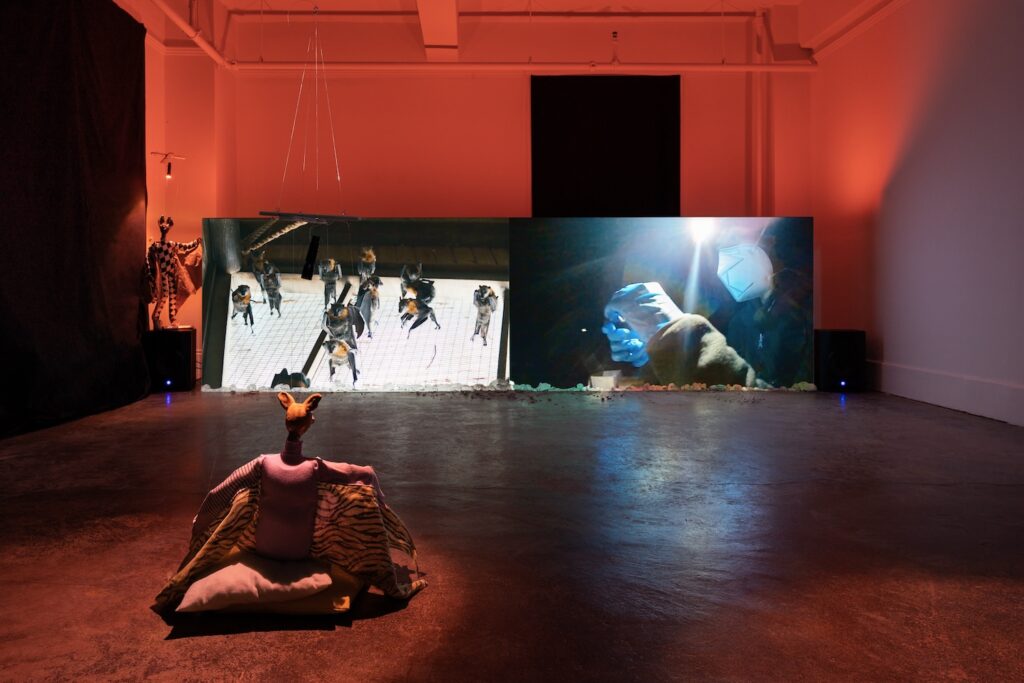Gabi Dao, Hold these questions close
Vancouver
January 18 – February 24, 2024
A surprising assembly of objects welcomes us as we enter the gallery space of Unit 17, newly located on West Hastings Street. In a dawn-like setting, ten bat marionettes are gathered together in the centre of the room and seem caught up in an important conversation. Other bats are sitting here and there, perched on the ceiling pipes or resting on buckets full of dry clay. On the ground, a large mover’s padded blanket, edged with dry clay, frames the gathering, perhaps creating a stage for this wildlife-led event. The bats, made of ceramic and textile, are imbued with a unique character in the way they are dressed. Denim, checkered patterns and colourful fabrics of corduroy, satin and other textures are sewn together to produce fashionable and distinctive outfits.
A variation of the exhibition What breaks on the horizon? shown at the Southern Alberta Art Gallery Maansiksikaitsitapiitsinikssin from October 14, 2023, to January 13, 2024, Hold these questions close focuses our attention on the figure of the bat. In this work, multidisciplinary artist Gabi Dao “considers the bat at a unique set of intersections between ecology and economy, pestilence and good fortune, sight and sound, as well as alienation and belonging.”1 Dao’s work plays on these contrasts to address the intertwining of racial capitalism and ecology, and to offer a counter-story in which the nocturnal animal evokes a sense of whimsicality. Rooted in the tradition of puppetry, the sculptures infuse the bat with playfulness and tactile attraction: suspended from their strings, the marionettes are charged with performative qualities. These punk-like, more-than-human creatures, wearing recycled apparel made with second-hand clothing—some the artist’s friends donated—and scraps of found fabric, defy the nature-culture order and challenge the very idea of categorization.
Adjacent to the sculpture installation, the second room of the gallery has been turned into a black box where Dao’s two-channel experimental film Lucifer Falls from Heaven at Dawn (2023) is shown. The main character of the film, a bat marionette named Lucifer, fell to the earth after flying into a wind turbine in Alberta. Beginning their journey at the foot of Turtle Mountain, they scramble through ruins—known as Frank Slide, one of the faces of the mountain that collapsed in 1903 due to coal overmining practices—with the aim of finding their kin in a world where bats are significantly depleted. Images of Lucifer being animated in the landscape or in a green screen environment are intertwined with documentary-like sequences in which biologists search for bats while using technologies that heighten their audio and visual abilities.
Bats’ communication is mostly inaudible to us. They share information with each other through high frequency chirps, screeches and songs. Human hearing is limited to frequencies between 20 and 20,000 waves per second, while bats can emit and hear sounds at frequencies that are over 100,000 waves per second. In their video and sculpture installation, Dao theatricalizes the concept of (in)audibility and plays on the tensions that arise between the human audience and the more-than-human characters. There is a sense of familiarity emanating from the bat marionettes as they adopt anthropomorphic postures and wear expressive and personalized clothing. Yet it feels like we don’t quite fit in.
Dao engages with the concept of otherness and prompts reflections on racism and xenophobia. In the wake of the COVID-19 outbreak, false theories claimed that the virus came from bats and scrutinized social and scientific practices amongst Chinese people, and more broadly the Asian community—especially targeting the East-Asian diaspora in Western countries. The process of othering at the core of racism obliterates a sense of similarity or connectedness between people. As such, it dissolves empathy and lessens one’s reaction to the consequences or harm affecting another group of people. Through this process, the other is conceived of as a socially “uncharismatic” being. In Dao’s work, this stigmatized other regains power and agency by challenging expectations and mobilizing refusal patterns, ultimately countering a full understanding or access to visuality and audibility.
In the film, the light-hearted figure of the marionette contrasts with stylistic elements and shooting techniques borrowed from horror movies, such as the use of low-key lighting or shaky camera work. The dark component associated with horror might not be such a bad thing: it creates a space for safety, where hope and freedom coexist in the shadow of injustice and biodiversity extinction. As nocturnal animals, bats are active at night to avoid predators and heat, in addition to having a great amount of food available and few competitors. This juxtaposition is productive, as it unfolds the potential of the in-between and stretches the interstitial—a forever dawn.
While bats play an essential role in the health of our ecosystems, they are predominantly valued for—and confined in—their contribution to agriculture as insectivores. “Am I worthy of your protection?” asks Lucifer. The real horror here is the fact that millions of bats have died from the white-nose syndrome, a fungal disease that has been attacking North American bats since 2006. In Canada and the United States, programs have been implemented to carry out research on prevention and treatments. Dao’s film questions the proliferation of conservation efforts in light of the impact of bats’ diet on the economy, which “saves agriculture in the billions.” Hold these questions close substantially addresses the ecology/economy dilemma, or rather “the conditions in which Otherness is tolerated under capital.”
According to Jackie Billotte, Ph.D. Candidate in the Department of Agricultural Biology at Colorado State University, “When people find an animal more appealing, they are more likely to donate money for conservation or support conservation initiatives. This method, however, allows humans to pick winners and losers in nature. Left behind are those species deemed ‘non-charismatic fauna.’”2 While raising awareness on this issue, Dao’s video and sculpture installation overturns this collective vision and provides alternative narratives and physical evidence. The marionettes are wearing tiny shoes—what could make them more charismatic?
1See exhibition text. [Online]: www.unit17.org/gabidao-holdthesequestionsclose
2Jackie Billotte, “It Must Be Exhausting Always Rooting for the Anti-Hero: Why non-charismatic fauna deserves some spotlight,” Colorado State University, School of Global Environmental Sustainability, 2023. [Online]: https://sustainability.colostate.edu/humannature/non-charismatic-fauna-deserves-spotlight/
Maude Johnson is an author, curator, and contemporary art consultant. Her writing and curatorial projects focus primarily on performative practices and curatorial issues. Her exhibition projects have been presented at Galerie de l’UQAM (Montréal, 2022), at Regart artist-run centre (Lévis, 2020), at Critical Distance Centre for Curators (Toronto, 2018), and in the Leonard & Bina Ellen Art Gallery’s SIGHTINGS off-site exhibition space (Montréal, 2016). Her writing has appeared in Esse and ESPACE art actuel magazines, and in a number of art publications and exhibition brochures.






